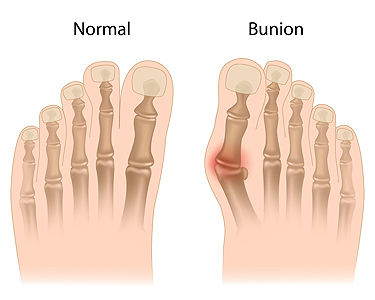Bunions are bony growths that appear along the outside of the foot at the base of the big toe joint. They are thought to occur in response to excess pressure and friction on the toes from wearing ill-fitting shoes, as well as due to a genetic predisposition for bunions. This common toe deformity can be painful, as the bunions rub against shoes and cause the big toe to move out of alignment and towards the smaller toes. There are a variety of treatment methods available for bunions. Conservative methods can be prescribed to manage the symptoms of a bunion. These may include wearing wider, more supportive shoes, wearing orthotics such as toe stretchers, splints, or bunion pads, taking over-the-counter medications to reduce pain, and applying ice to the bunion to decrease inflammation. Bunions can be removed permanently through surgery. If you have painful bunions, talk to your podiatrist about potential treatment options today.
If you are suffering from bunion pain, contact Dr. James D. McAlexander of Gig Harbor Foot and Ankle Clinic. Our doctor can provide the care you need to keep you pain-free and on your feet.
What Is a Bunion?
Bunions are painful bony bumps that usually develop on the inside of the foot at the joint of the big toe. As the deformity increases over time, it may become painful to walk and wear shoes. Women are more likely to exacerbate existing bunions since they often wear tight, narrow shoes that shift their toes together. Bunion pain can be relieved by wearing wider shoes with enough room for the toes.
Causes
- Genetics – some people inherit feet that are more prone to bunion development
- Inflammatory Conditions - rheumatoid arthritis and polio may cause bunion development
Symptoms
- Redness and inflammation
- Pain and tenderness
- Callus or corns on the bump
- Restricted motion in the big toe
In order to diagnose your bunion, your podiatrist may ask about your medical history, symptoms, and general health. Your doctor might also order an x-ray to take a closer look at your feet. Nonsurgical treatment options include orthotics, padding, icing, changes in footwear, and medication. If nonsurgical treatments don’t alleviate your bunion pain, surgery may be necessary.
If you have any questions, please feel free to contact our office located in Gig Harbor, WA . We offer the newest diagnostic and treatment technologies for all your foot care needs.

